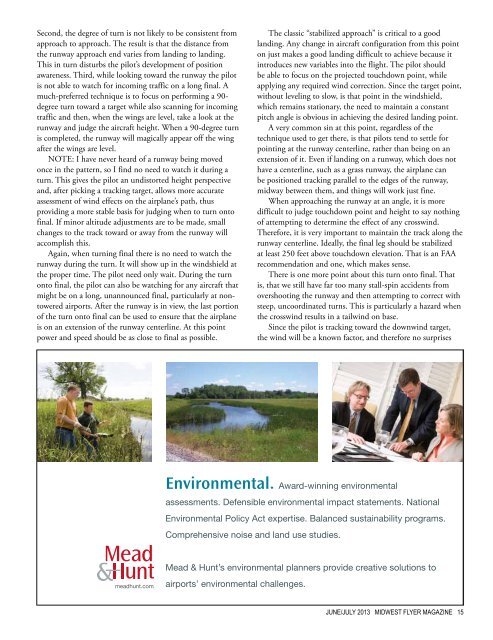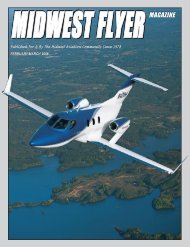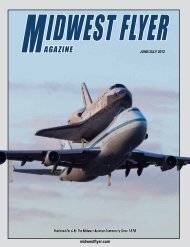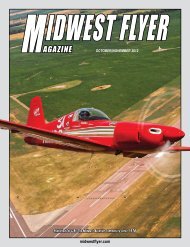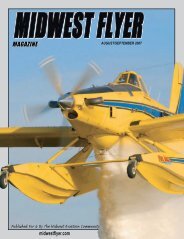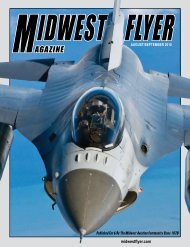You also want an ePaper? Increase the reach of your titles
YUMPU automatically turns print PDFs into web optimized ePapers that Google loves.
Second, the degree of turn is not likely to be consistent from<br />
approach to approach. The result is that the distance from<br />
the runway approach end varies from landing to landing.<br />
This in turn disturbs the pilot’s development of position<br />
awareness. Third, while looking toward the runway the pilot<br />
is not able to watch for incoming traffic on a long final. A<br />
much-preferred technique is to focus on performing a 90-<br />
degree turn toward a target while also scanning for incoming<br />
traffic and then, when the wings are level, take a look at the<br />
runway and judge the aircraft height. When a 90-degree turn<br />
is completed, the runway will magically appear off the wing<br />
after the wings are level.<br />
NOTE: I have never heard of a runway being moved<br />
once in the pattern, so I find no need to watch it during a<br />
turn. This gives the pilot an undistorted height perspective<br />
and, after picking a tracking target, allows more accurate<br />
assessment of wind effects on the airplane’s path, thus<br />
providing a more stable basis for judging when to turn onto<br />
final. If minor altitude adjustments are to be made, small<br />
changes to the track toward or away from the runway will<br />
accomplish this.<br />
Again, when turning final there is no need to watch the<br />
runway during the turn. It will show up in the windshield at<br />
the proper time. The pilot need only wait. During the turn<br />
onto final, the pilot can also be watching for any aircraft that<br />
might be on a long, unannounced final, particularly at nontowered<br />
airports. After the runway is in view, the last portion<br />
of the turn onto final can be used to ensure that the airplane<br />
is on an extension of the runway centerline. At this point<br />
power and speed should be as close to final as possible.<br />
The classic “stabilized approach” is critical to a good<br />
landing. Any change in aircraft configuration from this point<br />
on just makes a good landing difficult to achieve because it<br />
introduces new variables into the flight. The pilot should<br />
be able to focus on the projected touchdown point, while<br />
applying any required wind correction. Since the target point,<br />
without leveling to slow, is that point in the windshield,<br />
which remains stationary, the need to maintain a constant<br />
pitch angle is obvious in achieving the desired landing point.<br />
A very common sin at this point, regardless of the<br />
technique used to get there, is that pilots tend to settle for<br />
pointing at the runway centerline, rather than being on an<br />
extension of it. Even if landing on a runway, which does not<br />
have a centerline, such as a grass runway, the airplane can<br />
be positioned tracking parallel to the edges of the runway,<br />
midway between them, and things will work just fine.<br />
When approaching the runway at an angle, it is more<br />
difficult to judge touchdown point and height to say nothing<br />
of attempting to determine the effect of any crosswind.<br />
Therefore, it is very important to maintain the track along the<br />
runway centerline. Ideally, the final leg should be stabilized<br />
at least 250 feet above touchdown elevation. That is an FAA<br />
recommendation and one, which makes sense.<br />
There is one more point about this turn onto final. That<br />
is, that we still have far too many stall-spin accidents from<br />
overshooting the runway and then attempting to correct with<br />
steep, uncoordinated turns. This is particularly a hazard when<br />
the crosswind results in a tailwind on base.<br />
Since the pilot is tracking toward the downwind target,<br />
the wind will be a known factor, and therefore no surprises<br />
Environmental. Award-winning environmental<br />
assessments. Defensible environmental impact statements. National<br />
Environmental Policy Act expertise. Balanced sustainability programs.<br />
Comprehensive noise and land use studies.<br />
meadhunt.com<br />
Mead & Hunt’s environmental planners provide creative solutions to<br />
airports’ environmental challenges.<br />
JUNE/JULY 2013 MIDWEST FLYER MAGAZINE 15


